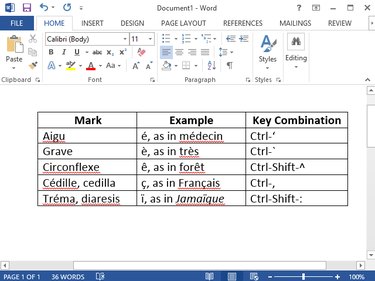Although you can use symbols or Alt-codes to create French letters in your documents, all modern versions of Microsoft Word include short cut keys to add French accent marks from a standard U.S. keyboard. These marks are not only required for proper spelling of words, but they also guide readers toward proper pronunciation.

Video of the Day
Aigu Accent
Hold the Ctrl key and type an apostrophe ('); release both keys and type the letter e to automatically add the aigu. This apostrophe mark appears above the letter and points down and to the left. It only appears over the letter "e" to change its pronunciation to "ay."
Video of the Day
Grave Accent
Hold the Ctrl key, type a grave symbol (`) and then release both keys. Type a vowel to automatically add the grave to the letter. The grave accent is similar to an aigu, but it points down and to the right instead of down and to the left. Although it might be applied to any vowel, it has no effect on the pronunciation. The exception is when it's applied to an "e," in which case it's pronounced "ehh."
Circonflexe
Hold the Ctrl and Shift keys and type a caret (^); release both keys and type a vowel. The hat-like circonflexe automatically appears over the vowel you type. Although this mark is important for spelling, it does not alter pronunciation.
Cédille
Hold the Ctrl key, type a comma (,), release both keys and type the letter c to include the cédille, which appends a comma-like mark to the bottom of the "c." This mark removes the hard "k" sound in favor of the "s" sound.
Tréma
Hold the Ctrl and Shift keys and type a colon (:); release all keys and type a vowel to add the tréma. Thi_s_ mark appears as two dots over a vowel and usually indicates the second of two consecutively placed vowels be pronounced separately.